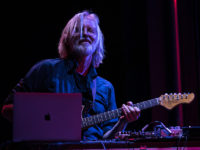Earlier in the week we introduced in this space the topic of “Nu jazz” that’s all the rage in Europe, and has represented one of the frontiers of fusion jazz these days. One of the pioneers of this collision of acoustic jazz and electronic music is the Norwegian keyboard player, composer and record company mogul by the name of Bugge (pronounced “boogie”) Wesseltoft.
Wesseltoft certainly didn’t come up with the idea of blending in contemporary electronic instruments with post-bop; Miles Davis, among many others, were doing that in the late sixties as a stepping stone to full-on electric fusion. What he and his colleagues did, though, was revisit this style as a fully formed idea rather than a transition toward one, using more up-to-date electronics sometimes accompanying vintage ones, along with some occasional sampling thrown in for good measure.
Wessletoft first laid out this vision in the ambitiously titled New Conception Of Jazz in 1996. That record also marked the launch of Wesseltoft’s Jazzland record label, which has since become home of other Nu jazz artists like Wibutree and the previously mentioned Eivind Aarset.
In actuality, the idea isn’t all that groundbreaking as the title of that album suggests; it’s a close cousin to the acid jazz and hip-hop jazz that emerged out of Britain and the US around 1990. Hell, Wally Badarou was doing instrumental electro-acoustic music throughout most of the eighties.
Anyway, sometimes Bugge’s blending of the styles don’t always work smoothly; a lot of it ends up sounding pretty close to straight-up electronica to me. But there is some pretty captivating music that comes out of him on those times when it does click.
The first track from his 2001 offering Moving is one of those such times where all the cylinders are firing. “Change” is deceptively simple on the surface; it’s built mainly on about four chords in a catchy progression played over on top of a dance groove. But Wesseltoft deftly adds layers to build up from a warm ambient passage before introducing programmed drums and a double-bass which states the theme. Over time, the percussion (I’m guessing that’s programmed, too) gets more insistent until it sounds as if it’s sweating as it reaches the front of mix.
About halfway through, the groove abruptly halts, but it’s a false ending and quickly restarts to signal the improvisional passage. Bugge’s electric piano solo is clearly inspired by Herbie Hancock’s Head Hunter days with it’s delicate balance of classic jazz voicings, funk vamps, and well-placed echoes and reverbs.
It’s not just Wesseltoft’s jammin’ like he’s Herbie that makes this tune an attractive piece of danceable jazz. That ultra-cool groove of “Change” is constructed by four decades of sounds coming together in perfect tandem: the acoustic bass of sixties jazz, the warm Fender Rhodes of seventies fusion, the icy synth of eighties dance music and the relentlessly percolating beat of nineties electronica. It’s almost like a scrapbook for the ears covering forty years of funk-jazz history.
The song winds down with layers disappearing one by one until the whole song vanishes just short of a ten and a half minute sprint. Or rather, it sure seems like a sprint. “Change” may not represent an entirely new conception of jazz. But it was well-conceived, nonetheless.
“One Track Mind” is a more-or-less weekly drool over a single song selected on a whim and a short thesis on why you should be drooling over it, too.
- Christian Marien Quartett – ‘How Long Is Now’ (2024) - April 18, 2024
- Dave Douglas, feat. James Brandon Lewis – ‘Gifts’ (2024) - April 11, 2024
- Thollem – ‘Worlds In A Life, Two’ (2024) - April 8, 2024




